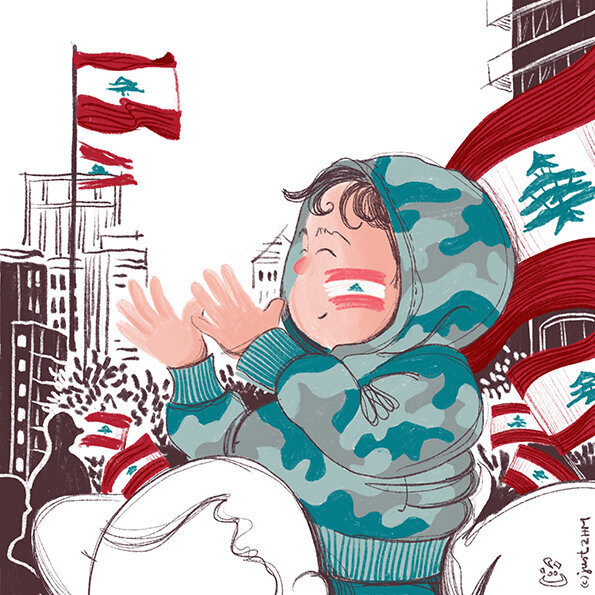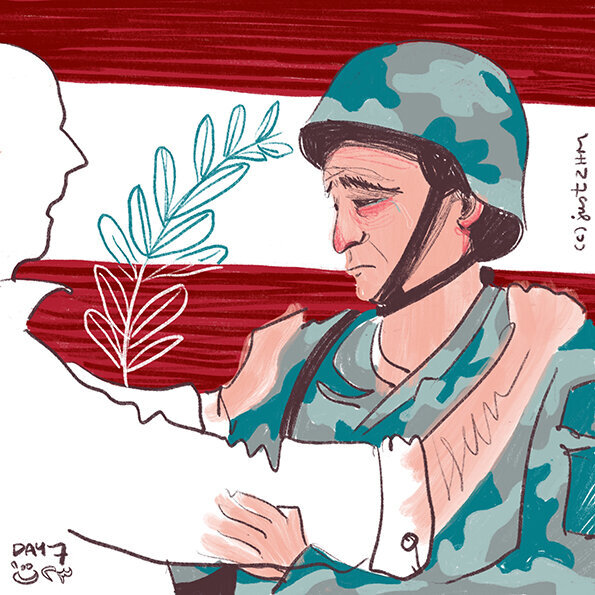The Lebanese
Revolution
A series by Zarifi Haidar Marin
A series by Zarifi Haidar Marin
All my illustrations are personal observations and direct expressions of how I feel and think. The Lebanese Revolution pieces are no exception. They are either depictions of moments that have moved me or personal interpretations of the events happening.
Some of these illustrations imitate reality; they are sketches of iconic images from the first days of the protests. Other pieces are more conceptual; they are built on visual and ideational parallels with Art History pieces, political-cartoon analogies, or heartfelt accounts of the strongest emotions evoked during the Revolution.
The colour palette is inspired by the Lebanese flag, with the colour red usually placed at the forefront of each piece. Most figures are inherently generic, to speak to the idea that not only are all the politicians the same, but that all Lebanese share the same fate regardless of their different backgrounds and affiliations.

The Joker
“... Nobody thinks what it’s like to be the other guy...to be somebody but themselves? They don’t. They think that we’ll just sit there and take it, like good little boys! That we won’t werewolf and go wild.” – Arthur Fleck, Joker (2019)
The Joker, the first illustration of the Lebanese Revolution 2019 series, depicts how we walked into this revolution: as individuals broken by a malfunctioning socio-economical system, unable to take it any longer, ready to fight.

The Unity
The second illustration of the series shows how we have decided to walk through the Lebanese Revolution: united, despite all our differences.
People have woken up from decades of corruption and governmental mismanagement and have united to ask for their rights. Lebanese people of every age, social class and religious background are marching together; their voice has cut across the sectarian lines that have plagued the country since the civil war.

The Joy
It is October 19, 2019. The Revolution DJ and protesters in Tripoli’s Al Nour Square are capturing the imagination of Lebanon and the world. The true image of Tripoli is displayed and the city becomes the epitome of the joyful spirit of the Lebanese Revolution protests. The illustration captures, and marks, this celebration.

The Greed
Inspired by Goya’s ‘Saturn Devouring His Son’ (c. 1823-1819), The Greed is a portrait of a titan consuming one of his children. This titan, however, does not come from mythology, but from our everyday reality. The titans of the corrupt Lebanese government have been devouring their “sons” one after the other. Lebanese politicians’ greed and fear of being overthrown have lead to the destruction of the country. Unless they are stopped, the future generations will only meet the same fate.

The Future
The future of Lebanon should be brighter; we owe that to our children. We are protesting to make things right and, along the way, our children are learning life lessons, unedited and unaltered by political or sectarian affiliations.
The future of Lebanon will be brighter.

The Pain
It is October 23, 2019. Roads all around Lebanon are still half-to-completely closed by protesters. The army members are given orders to reopen these roads. The soldiers have to choose between their duty and their own countrymen. They have to confront the crowds and they do so with heavy hearts, teary eyes, but no force.

The Puppet
It is October 24, 2019. A long awaited for TV appearance takes place. The protesters’ expectations are not met; the protagonist of the play being screened seems deaf and blind.
He has not heard the people’s chants and shouts.
He has not seen their grand gestures and signs.
He is not mute though; but, after hearing what he has to say, the people wish he were.

The Eggupation
Beirut’s iconic war-scarred egg-shaped cinema, which was left abandoned and inaccessible for decades, has been revived during the protests.
In just a few days, it has been transformed into a space for collective creativity and dialogue. It might not be publicly owned, but it has become a significant addition to Beirut’s extremely short – and almost nonexistent – list of ‘public’ spaces.

The Resilience
It is October 29, 2019. Supporters of the ruling elite attack the protesters and destroy their tents in Downtown Beirut. Few minutes later, the protesters are cleaning the area and setting their tents once more. This illustration captures one of those minutes.
As Jean-François Millet’s ‘The Gleaners’ (1857) was a reminder that the French society was built upon the labor of the working masses – who could overturn the upper classes if they were to revolt - this illustration reminds us that the Lebanese society is built upon the effort of the thinking masses who are strong and resilient enough to overturn the corrupt ruling elite.

The Women
Since the onset of the Revolution on October 17, 2019, Lebanese women from all ages and backgrounds have united in their fight against corruption and patriarchy, leading protests across the country and inspiring many other women worldwide.
Inspired by Eugène Delacroix’s ‘Liberty Leading the People’, this piece celebrates the Lebanese women leading the Revolution. It is a humble tribute to their courage, strength and key role in redefining Lebanon’s history and shaping its future.

The Scream
Though the visual composition of this illustration is inspired by Edvard Much’s ‘The Scream’ (1893), there is no conceptual parallelism. His iconic agonised face is simply used to depict the side effects of the Revolution’s no. 1 ear-worm.
Humour makes everything better, and our Revolution is not an exception to the norm.

The Horror
It is November 12, 2019. A second TV appearance reignites the protests. A verbal argument scales into physical altercation and, few minutes later, a bullet ends a life and forever marks many others.
A brother, a husband, a father is killed.
A sister, a wife, a son witness an assassination.
I, and many others, still cannot believe what happened.

The Hope
Lebanon is depicted as a heavily pregnant woman bowing her pensive head towards her bare breast and burgeoning abdomen. She has seen death and destruction but, as Herma in Gustav Klimt’s “Hope II” (1907), she knows that inside her grows a new life full of beauty and hope; her eyes express that.
At the foot the illustration, there are other women.
They are the women of the Revolution, who are fighting, praying, and making sure the expected new life is delivered safely.
Zarifi Haidar Marín is a Venezuelan-born and Beirut-based architect, urban designer and self-taught illustrator. She holds a BS degree in Architectural Engineering (2005) and a MS degree in Urban Design from the American University of Beirut (2016). She has worked as an architectural consultant in a wide range of projects in Lebanon and the region and has illustrated a couple of award winning children books. Zarifi is passionate about art and design and spends most of her free time taking photos, creating and drawing. She illustrates to smile and get smiles from those looking at her work. You may find her on her website or on Instagram (@justZHM).
All images courtesy of the artist © Zarifi Haidar Marín